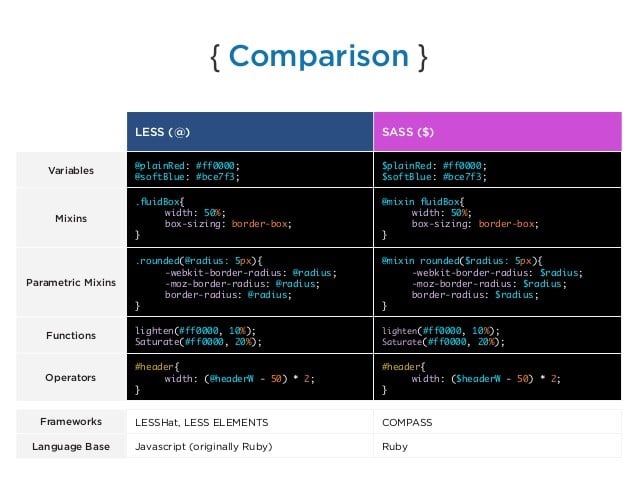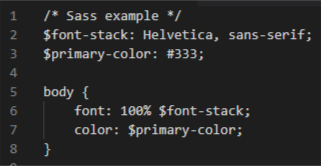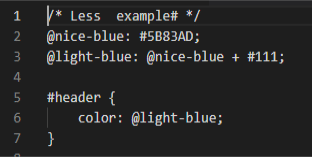SASS vs LESS: What to Choose?


Sass and LESS are two popular CSS Pre-processors. One of these tools is a scripting superset of CSS that makes writing CSS code more comfortable. Both these CSS Pre-processors – SASS vs LESS are unique template expansions that make planning and developing simpler and more effective.
The battle for the title of the most suitable pre-processor is LESS vs. SASS, or, as their name indicates, Leaner Style Sheets versus Syntactically Awesome Style Sheets.

Although these tools are similar, different web developers go for different options — and in this article, we’ll analyse whether LESS or SASS is the most suitable fit for you.
Both Sass and LESS accumulate into CSS templates with the goal that programs can understand them. This is an important advancement since present-day programs can’t be perused “.SASS or LESS file types”.
It has been some time since the idea of CSS Pre-processor made its presentation into the backbone of the front-end web development work process and changed how we code CSS.
On the off chance that you plan on being in the realm of web development, it’s a smart idea to be knowledgeable in one of the two pre-processors (SASS & LESS), if not both of them.
Both Sass and LESS are integrated into a CSS framework for browsers to read. Regardless of anything else, they have plenty of likenesses.
They make writing CSS code less complex, more object-oriented, and more readable, and can further make developers’ tasks a little interesting.
Here are some of the key differences for developers to distinguish between the two tools:

LESS– LESS is additionally a CSS pre-processor that empowers a client to tweak, maintain, oversee, and reuse templates for a site. LESS is a unique language and can be utilized on various programs.
LESS is written in JavaScript and aggregates information extremely quickly, and compiles data at a faster rate. It likewise helps in keeping the code secluded and makes it readable and variable.
SASS– SASS is a CSS (cascading style sheet) pre-processor that assists with lessening redundancies in CSS and in the end saves time. It is an augmentation of CSS that helps in saving time.
It gives a few highlights that can be utilized to make templates and help keep up the code. It is viewed as a superset of CSS and is coded in Ruby.
Let’s begin with the very basic step, Installation. LESS and SASS are made on different platforms.
LESS- Installing LESS is as easy as linking the JavaScript library to your HTML document. LESS is purely written in JavaScript.
There are some GUI applications available to assist in compiling LESS to CSS, and most of them are free and work very well, e.g., LESS.app and WinLess.
SASS – SASS, on the other hand, needs a compiler written in C++ and also needs the implementor for this compiler of the selected language.
If your project is running on the Node.js application, you’d require to install the Node compiler. There’s one for Go, Python, Ruby, and even C#.
Also, each of the platform versions may also need a different version of the compiler, so you also need to download the compatible compiler.
LESS – LESS uses JavaScript for control of values. It additionally utilizes predefined values to control HTML components and makes changes to various parts of a template.
It likewise has values or functions for changing tones like round work, ceil function, floor function, and percentage function.
The genuine contrasts are found rather in the logical functions: LESS offers clients the chance to possibly enact or activate Mixins when explicit circumstances occur. This is a useful element; however, it addresses the degree of legitimate connections or logical links in LESS.
SASS– SASS empowers you to make your own capacity and use it to meet the client's needs. We can call functions by utilizing the function name with parameters.
Like Mixin capacities can likewise be gotten to acknowledge various parameters worldwide and furthermore. Values can be returned using the @return function.
SASS offers loops and case differentiations, as known from programming languages.
The following are the highlights of LESS:
– A code can be written in a cleaner and coordinated way.
– New styles can be characterized according to the prerequisite, and they tend to be reused whenever needed.
– It is created in JavaScript and is a superset of CSS.
– It is a light-footed tool, and it helps diminish redundancy.
The following are the highlights of SASS:
– It is steady, incredible, and compatible with different renditions(versions) of CSS.
– It is a superset of CSS and is written in JavaScript.
– It has its own punctuation and syntax, and it accumulates to readable CSS.
– It is an open-source extension.
Looking for Web Application Development Services
Send us your requirements, and we will get back to you with a quote.
-LESS has more exact error messages for altogether tests, and it additionally clarifies the right area where a mistake has happened.
-SASS can report errors in syntax in its structure.

-Mixins help in making styles that can be utilized and reused anywhere in your template without reproducing non-semantic classes.
In SASS, mixins can store various values or parameters and call that function. Mixin likewise empowers uses of underscores and hyphens. Sass and LESS have extensions accessible to integrate mixins.


LESS-
The LESS documentation is visually appealing and easier to follow for first-time/ newbie users.
SASS–
The SASS documentation requires either substantially more of base information, or successive cross-references with a wiki’s during setup.
Both of these are the popular options of today; now, let us discuss some of the primary differences between them:
LESS offers the ability to build guarded mixins that function only when specific conditions are fulfilled. SASS, on the other hand, believes that natural robustness and concept are more important, and therefore, utilizing Compass, it makes that happen.
LESS makes it possible to create robust libraries that can be reused whenever needed. This supports CSS3 to be more user-friendly. The pre-processor software also stays up to date with these libraries. On the other hand, SASS provides Compass, which helps to control the situation in advance. LESS offers libraries that provide marketing-y support charts and are quite powerful when compared to SASS.
Both pre-processors – SASS vs LESS are widespread among web designers, and both of them share some of the same properties: SASS and LESS permit the use of variables and mixins, with one difference, though, LESS uses JavaScript while SASS is based on Ruby.
But the actual differences are seen instead in the logical functions: LESS provides users the opportunity to simply activate mixins when specific situations arise. This is a useful feature, but it means the extent of logical links in LESS. SASS, on the other hand, delivers loops and case distinctions as learned from programming languages.
In the end, it totally depends on the developer’s choice or preference to choose between SASS and LESS, depending on which type of project they are developing. Being front end developer, it’s my recommendation that one should keep on experimenting with different technologies to enhance their Skills and to provide the best possible solution; and Sass is something that has a great scope in the near future. Hope you find this article informative and interesting. Happy Learning!
Leverage expert developers skilled in SASS, LESS, and modern CSS frameworks to create fast, responsive, and maintainable web interfaces.
Get Front-End Development Help1) Why is SASS considered better than LESS?
In SASS, if a global variable takes the local value and the global variable is overwritten. Media queries can be utilized to add blocks to the bottom of your primary stylesheet. When working with LESS or SASS, users can get together the styles by utilizing nesting. SASS provides a better effect when compared to LESS in this regard.
2) What is the use of the Mixin function in Sass? What is the definition of DRY-ing out a mixin?
A mixin lets you describe styles that can be reused throughout the stylesheet without any need to resort to non-semantic classes like .float-left .DRY-ing out of mixing means breaking it into static and dynamic parts. The dynamic mixin is the one that the user is going to call, and the static mixin is described as the portions of information that would otherwise get duplicated.
3) How is interpolation used in Sass?
In Sass, you can describe an element in a variable and interpolate it within the Sass code. This is helpful when you need to keep your modules in separate files.
4) Explain how Mixins are useful?
Mixins allow implanting all the properties of a class into another class by incorporating the class name as one of its properties. It is simply like variables, but for whole classes.
We are more than just developers and consultants—we are your partners in navigating the digital landscape. Let us be the engine behind your next big success while you focus on your core vision.
Explore Opportunities!